4
Proletkult Leadership:
The New and the Old lntelligentsia
The Russian Revolution, like all revolutions, challenged the authority of the old elites and the long-standing patterns of social hierarchy. Once in power, however, the Bolsheviks quickly discovered that if they wanted to build a stable system, they had to construct a new elite to take the place of the old one. To find the necessary human resources, the party reached out to the lower classes, a solution that best fitted the spirit of the revolution. However, this solution was not enough to sustain the state. The new leaders promoted from the proletariat and peasantry often had little training or experience for their jobs. In order for the regime to survive it employed both force and persuasion to induce intellectuals and experts trained under tsarism to serve the Soviet government.
The creation of a stable, accomplished, and loyal elite was a major preoccupation of the regime during the early Soviet years. The state's solution, to mold a hybrid leadership from representatives of both the lower and the old privileged classes, was one born of necessity. Nonetheless, it raised objections from workers' groups, which resented the status this course conferred on their old class enemies. It also dismayed
revolutionary idealists, who envisioned an egalitarian society without an elite at all.
To their credit, Bogdanov and his allies in the Vpered circle had anticipated many of these difficulties long before the October uprising. They argued that in order for the coming revolution to be successful, the working class would have to generate its own elite before it attempted to take power. But the solution they had proposed, the slow and painstaking education of a working-class intelligentsia before the revolution came, was of little relevance after 1917. Proletkultists, like government leaders and party officials, had to devise new schemes to solve the problem of revolutionary leadership.
Because the movement placed such emphasis on proletarian creativity and independence, its proponents often asserted that the working class could undertake the management of revolutionary society on its own. Proletkultists were famous for their glorification of proletarian abilities, something particularly evident in the organization's artistic productions. "We are everything, we are everywhere, we are the conquering fire and light," proclaimed the poet Vladimir Kirillov. "We are our own God, Judge, and Law."[1] Such sentiments inspired denunciations of the old intelligentsia and its place in revolutionary society. No wonder, then, that many scholars see the Proletkult as one of the most extreme advocates of workers' control.[2]
Yet despite its radical reputation, the Proletkult could not avoid the problems faced by other revolutionary institutions in the early Soviet years. The Russian proletariat was too small, too overburdened, and too inexperienced to take power on its own. New state commissariats tried to induce tsarist bureaucrats to remain in their old positions. The Red Army
[1] Vladimir Kirillov, "My," in Stikhotvoreniia i poemy , by Vladimir Kirillov (Moscow, 1970), p. 36.
[2] See, for example, Kendall E. Bailes, Technology and Society under Lenin and Stalin: Origins of the Soviet Technical Intelligentsia (Princeton, 1978), p. 59; and S. A. Fediukin, The Great October Revolution and the Intelligentsia , trans. Sinclair Lourit (Moscow, 1975), p. 47.
could not fight the Civil War without the aid of tsarist generals. In Soviet factories a combination of economic hardship and severe political pressure forced workers to accept the aid of managers and engineers. And even the most iconoclastic Proletkuh participants discovered it was not possible to engage in cultural creation without the services of the old cultural elite—the writers, painters, and educators who had gained their experience under the old regime.
The Ideals of Proletkult Leadership
Proletkult theorists posed challenging questions about authority, class identity, and expertise in the new revolutionary society. They hoped to nurture an ethos of socialism that was based on the spirit of collectivism. At the same time, they wanted to advance new proletarian intellectuals to prove that the working class had the skills and the resources to take charge. Finally, they intended to make use of the talents of the old intelligentsia in a way that would augment, not inhibit, proletarian creativity. These were daunting and sometimes contradictory goals.
For Proletkultists socialism meant the victory of the collective over bourgeois individualism, the victory of "we" over "I." The principle of collectivism pervaded Proletkult organizational guidelines: power was delegated to groups rather than to individuals. The national charter gave control to large leadership councils elected at periodic conferences.[3] There were no written guidelines about the class makeup of the leadership, surely because Proletkult planners assumed that a collective of worker-members would select a collective of worker-leaders. The rules also did not describe power relationships within the leadership councils; there were no instructions about conventional offices like president, vice president, or secretary. This same commitment to collectiv-
[3] "Plan organizatsii Proletkul'ta," Proletarskaia kurl'tura , no. 6 (1919), pp. 27–28.
ism emerged in any number of local manifestoes and guidelines. Participants in one Kolpino art section declared that they wanted "neither literary generals nor colonels." Their group would be composed of equals who might know a little more or a little less.[4]
Despite this commitment to egalitarianism, many local groups followed the organizational patterns set by the national Proletkult and common practice, choosing presidents, subordinate officers, and the leaders of artistic divisions. Ideally, these officials were elected at periodic conferences and could be recalled if they abused their position, but these democratic principles were not always realized. Some circles began work without founding conferences, and others never reconvened after the opening session.[5] Of course, even when leaders were confirmed through elections, they could exercise considerable personal influence over local cultural agendas.
This tension between group leadership and personal authority was partially implicit in the organization's goals. The foremost Proletkult theorist, Aleksandr Bogdanov, did not believe that collectivism meant the denial of individual accomplishment. Only selfish bourgeois individualism would be extinguished under socialism. Human individuality, separate but tied to the good of the collective, would flower in the new society.[6] In less abstract terms many Proletkultists were proud of the talents of individual worker-artists and organizers. When Fedor Kalinin, the best-known proletarian leader, died in early 1920, the Proletkult press abounded with moving remembrances of his exploits, and Bogdanov praised him as
[4] "Ot literaturnoi sektsii Kolpinskogo Proletkul'ta," Mir i chelovek , no. 1 (1919), p. 10.
[5] Both the Izhevsk and Pudemskii factory Proletkults began without conferences. The Archangel organization reported only one conference between its founding in early 1920 and late 1921. See local questionnaires in Tsentral'nyi Gosudarstvennyi Arkhiv Literatury i Iskusstva [henceforth cited as TsGALI] f. 1230, op. 1, d. 117, ll. 10, 54 ob.; d. 118, l. 39.
[6] Zenovia A. Sochor, Revolution and Culture (Ithaca, 1988), pp. 137–38.
the best example of the new kind of worker-intellectual.[7] The achievements of this gifted individual and others like him symbolized the abilities of the entire proletariat.
Inevitably, this complex interrelationship between the individual and the collective caused confusion. Not only was there ample room for power abuses, but organizations were often torn between conflicting goals. Should they devote their resources to the education and training of the proletariat as a whole? The advocates of this radical course denounced all forms of hierarchy, including the cultivation of a worker-elite to stand at the forefront of the proletariat.[8] Or should they nurture the talents of the most promising workers? Those in favor of this position believed that it was the best way to show the accomplishments of the working class and the power of proletarian culture. Each position brought its own dangers. If the Proletkult was too egalitarian, then it could easily turn into a basic educational movement whose activities were barely distinguishable from those of Narkompros. If it catered to the most sophisticated, it could lose its ties to the masses.
The role of the old intelligentsia posed equally difficult dilemmas. Rancorous debates about intellectuals' place in a proletarian movement began at the founding conference in 1917 and continued unabated throughout the Proletkult's history. In a revolutionary world split between a plebeian "us" versus a patrician "them," the intelligentsia was easily singled out as an implacable class enemy. Proletkult publications bristled with denunciations of the educated elite. The worker-writer Aleksei Samobytnik-Mashirov insisted that the Proletkult rely on the proletarian intelligentsia alone. "Only in it can there be a guarantee of proletarian culture"[9] Fedor
[7] A. A. Bogdanov, "Novyi tip rabotnika," in Sbornik pamiati F. I. Kalinina (Rostov on Don, 1920), pp. 33–38.
[8] See the denunciation of any kind of intelligentsia in R., "Sushchnost' intelligentsii," Griadushchaia kul'tura , no. 1 (1918), p. 20.
[9] A. Mashirov, "Zadachi proletarskoi kul'tury," Griadushchee , no. 2 (1918), p. 10.
Kalinin warned that intellectuals possessed a different worldview than the working class. No matter how sympathetic they were, they still would draw workers away from proletarian forms of expression.[10]
Such outbursts revealed the lower classes' longstanding distrust of the intelligentsia, but they served mainly a rhetorical function. As president of the Petrograd Proletkult, Samobytnik-Mashirov helped to recruit intellectuals to his programs. Kalinin shared the leadership of the central Proletkult with his friends and mentors, the intellectuals Bogdanov and Lebedev-Polianskii. Many other lower class participants welcomed intellectuals' aid without any ambivalence at all.
The national organization contributed to the confusion, sending out very mixed messages on this complex issue. Proletkult theorists worried that the intelligentsia might gain control of the creative processes in local organizations, and they warned about the dangers this posed to proletarian culture. But they also recognized that the movement could not survive without some intellectual aid. In the words of the first Proletkult president Lebedev-Polianskii, the socialist intelligentsia who came to the Proletkult had kul'turnyi stazh , cultural experience.[11] That was one asset a cultural organization could not forgo.
Torn between suspicion and need, the central Proletkult tried to discover ways to harness intellectuals' experience while limiting their influence. At the first national conference delegates decided that the Proletkult would make use of intellectuals' skills "as far as possible."[12] The 1919 national charter
[10] Fedor Kalinin, "Proletariat i iskusstvo," Proletarskaia kul'tura , no. 3 (1918), p. 13. See also I. Sadof'ev, "Na solnechnyi put'," Griadushchee , no. 10 (1918), pp. 15–16 and S. Kluben', "S burzhuaznogo Parnasa—v Proletkul't: O 'proletarizatsii pisatelei,' " Griadushchaia kul'tura , no. 3 (1919), pp. 17–18.
[11] "Revoliutsiia i kul'turnye zadachi proletariata," Protokoly pervoi Vserossiiskoi konferentsii proletarskikh kul'turno-prosvetitel'nykh organizatsii, 15–20 sentiabria, 1918 g. , ed. P. I. Lebedev-Polianskii (Moscow, 1918), p. 20.
[12] Ibid., p. 29.
spelled out just how far that was. A real knowledge of proletarian spirit and character could only be achieved through long exposure to workers' lives and customs, something very difficult for nonworkers to achieve. Therefore, sympathetic nonproletarian elements would be limited to technical and auxiliary roles in Proletkult creative work.[13]
Yet this simple solution, which turned intellectuals into outside helpmates in an organization supposedly composed of and led by workers, proved to be very difficult to implement. The old intelligentsia's cultural experience granted them authority that the rules of collective management could not confine. Committed artists and educators gained considerable influence in local circles and left an indelible mark on the movement's cultural programs.
By addressing the problems of leadership and class identity, Proletkultists wrestled with the contradictions posed by the socialist revolution itself. Could egalitarianism be reconciled with skill and talent? Was it possible to nurture a new intelligentsia without conferring power on the old? In the variety of answers that participants found to these questions they inadvertently acknowledged the limits of proletarian power and redefined the language of class control.
Leaders from the Lower Classes
The Proletkult owed its existence in large part to the efforts of self-made artists and thinkers from the lower classes who had won their education with great difficulty in exile schools and adult education circles under the old regime. For these talented individuals the Proletkult was a showcase for their accomplishments and also a way to further their education in an environment designed to meet their needs. The most visible worker-leaders were those who served on the national central committee and presidium. Although proletarians always
[13] "Plan organizatsii Proletkul'ta," Proletarskaia kul'tura , no. 6 (1919), p. 27.
shared these posts with nonworkers, they held a significant percentage of the top jobs, and their numbers grew over the years.
The first cohort of proletarian leaders, elected at the 1918 national convention, included Fedor Kalinin, Aleksei Samobytnik-Mashirov, Vasilii Ignatov, Mikhail Gerasimov, Vladimir Kossior, Vladimir Kirillov, Karl Ozol-Prednek, and Ilia Sadofev.[14] Except for the actor Ignatov and the union activist Kossior they were all writers who had tried their hands at creative work and criticism in a variety of socialist journals and newspapers. The careers of four—Kalinin, Kirillov, Gerasimov, and Samobytnik-Mashirov—will serve as examples of this accomplished generation.
Easily the most important was Fedor Kalinin, an influential contributor to Proletarian Culture , head of the Proletkult division in Narkompros, and admired friend of Bogdanov and Lebedev-Polianskii. He was also the brother of Mikhail Ivanovich Kalinin, the future president of the Supreme Soviet under Stalin. Born into a peasant weaver's family in 1882, Kalinin began factory work at an early age. By 1901 he already faced exile for political activity. He was released in time to take an active part in the Revolution of 1905, for which he received a three-year prison term. When his sentence was over, Kalinin began underground agitation for the Bolsheviks in Moscow. Because of his sympathies for the left Bolshevik faction, he made his way to the exile schools in Capri and Bologna, quickly distinguishing himself as a student and an organizer. He later joined Lunacharskii's circle for proletarian literature in Paris. While working at an airplane factory in France, Kalinin began to publish his thoughts on cultural creation in the journal Struggle (Bor'ba ) and the main journal of the Vperedists, Forward (Vpered ). His many writings on proletarian thought and culture earned him the title of "proletarian philosopher."[15]
[14] Protokoly pervoi konferentsii , p. 7.
[15] For a summary of Kalinin's life and accomplishments see Sbornik pamiati F. I. Kalinina . His most important works are reprinted in P. Bessal'ko and F. Kalinin, Problemy proletarskoi kul'tury (Petrograd, 1919).
Vladimir Kirillov was one of the best-known creative writers in the movement. His panegyric to proletarian power, the poem "We," is constantly cited as the prototype of Proletkult creation. Born in Smolensk in 1890, he went to a village school and began his working life as a shoemaker's apprentice. At the age of thirteen he left to join the merchant marines, later taking part in sailors' rebellions during the Revolution of 1905. For his role in the revolution, he received three years in exile. Once freed, he left Russia and traveled around the world, including an extended stay in the United States. Kirillov began his career as a writer while abroad, although he would not start publishing until just before the First World War. On his return to Russia in 1912 Kirillov refined his literary skills in classes at Countess Panina's famous People's House in St. Petersburg.[16] His first poetry collections, including Dawn of the Future (Zori griadushchego ) and The Iron Messiah (Zheleznyi messiia ), were put out by the Proletkult.
Another important organizer and writer was Mikhail Gerasimov. He was born in Samara in 1889, the son of a railroad worker. Gerasimov attended primary schools sponsored by the railroad and went to work at the age of nine. Like Kirillov and Kalinin, he quickly became involved in political activity and also faced imprisonment for his involvement in the Revolution of 1905. After his release Gerasimov resumed political agitation. Facing imminent arrest, he had to flee the country in 1907. He stayed in Europe for many years, where he continued his political work, even spending time in foreign prisons. In Paris he joined Lunacharskii's circle for proletarian literature and began to publish his work in socialist journals and newspapers. During the First World War, he volunteered to
[16] Vladimir Timofeevich Kirillov, "Avtobiografiia," TsGALI f. 1372, op. 1, d. 1, ll. 1–5; and Z. S. Papernyi and R. A. Shatseva, eds., Proletarskie poety pervykh let sovetskoi epokhi (Leningrad, 1959), pp. 515–17.
serve in the French army, but was sent back to Russia for engaging in antiwar propaganda. In 1917 Gerasimov became a leading Bolshevik organizer in his native Samara, where he took charge of the city Soviet and helped to form the local Red Guard unit.[17]
Aleksei Mashirov, who gave himself the pen name "Samobytnik" (from the Russian word for "original" or "distinctive"), was born in St. Petersburg in 1884. The son of an artisan, he was sent to primary school in the city and then, at the age of twelve, to a metalworking plant. His political commitments led to arrest and exile after 1905. On returning to St. Petersburg in 1908 Samobytnik-Mashirov joined the Bolshevik faction and began to write literature, taking classes in Panina's People's House. His poetry appeared in Gorky's first collection of workers' writing and in Pravda . A founder of the Proletkult in 1917, Samobytnik-Mashirov became president of the Petrograd city organization.[18]
These worker-intellectuals shared many common experiences. They were all approximately the same age and had left manual labor behind to pursue political and cultural work. Their history in the revolutionary movement also followed similar paths. Bolsheviks of long standing, they had taken part in the Revolution of 1905 and served time in prison and exile. There were also strong friendship ties between them. Kalinin knew Gerasimov from the exile schools; Gerasimov was a friend of Kirillov's; and Kirillov had studied with Samobytnik-Mashirov and another proletarian author, Ilia Sadofev, at the Countess Panina's People's House.
It is difficult to overestimate the importance of these four writers in the formation of the Proletkult. Kalinin and Samobytnik-Mashirov, together with Vasilii Ignatov and two other writers, Aleksandr Pomorskii and Aleksei Gastev, were key
[17] F. Levin, "Mikhail Gerasimov," in Stikhotvoreniia , by Mikhail Gerasimov (Moscow, 1959), pp. 7–11.
[18] Papernyi and Shatseva, Proletarskie poety , pp. 528–29; and Kratkaia literaturnaia entsiklopediia (Moscow, 1962–1978).
organizers of the first Proletkult in 1917.[19] Kalinin, friend and former student of Lunacharskii's, provided the crucial links between the Proletkult and Narkompros. This circle of committed workers was also responsible for starting some of the most important local organizations. Kirillov and Pomorskii went to Tambov.[20] Gerasimov founded the Proletkult in his native Samara, where the local journal, Glow of the Factories (Zarevo zavodov ), bore the name of one of his poems.[21] Ignatov opened and led the Tula Proletkult and helped to initiate new organizations in the Caucasus.[22]
This first generation of Proletkult leaders was very anxious to make its mark as serious artists and thinkers, not amateurs who pursued their vocations on the side. They wanted the Proletkult's resources to be spent on developing the skills of the best representatives of their class, not on basic educational work to benefit the masses. The organization's first responsibility was to help the most talented, wrote Kalinin; they could then serve as role models for the others.[23] Such attitudes dulled their sensitivity to the problems of aspiring cultural activists who had not yet established themselves.
However impressive the qualifications of this cohort, their resources alone were not enough to sustain the organization.
[19] A. V. Lunacharskii, Vospominaniia i vpechatleniia (Moscow, 1968), pp. 164–66. Gastev was never elected to a position in the national organization and by 1919 had distanced himself from the Proletkult. See Protokoly pervoi konferentsii , p. 103; and Kendall E. Bailes, "Alexei Gastev and the Controversy over Taylorism, 1918–1924," Soviet Studies , vol. 29, no. 3 (1977), pp. 373–94.
[20] "Soveshchanie o proletarskoi kul'ture," Griadushchaia kul'tura , no. 3 (1919), p. 25.
[21] See the local questionnaire in TsGALI f. 1230, op. 1, d. 117, l. 6; and Zarevo zavodov , no. 1 (1919), pp. 8–10.
[22] "Vypiska iz protokola Tul'skogo komiteta RKP," August 1, 1918, TsGALI f. 1230, op. 1, d. 1538, l. 8; and I. S. Smirnov, comp., "Tsennoe priznanie: Pis'ma proletkul'tovtsa V. V. Ignatova K. S. Stanislavskomu, S. M. Eizenshteinu, V. E. Meierkhol'du," Teatr , no. 12 (1976), p. 49.
[23] F. Kalinin, "O professionalizme rabochikh v iskusstve," Proletarskaia kul'tura , no. 7/8 (1919), p. 30.
Politically experienced workers were much sought after, and the Proletkult was rarely their only responsibility. Kalinin, for example, worked for Narkompros, the Communist Party, and the Red Army in addition to his responsibilities in the Proletkuh. He was killed by typhus in early 1920 while organizing a military newspaper on the Southern front. Kossior quickly put aside his Proletkult duties to assume party responsibilities in the Ukraine.[24] Others were disillusioned when the movement became too actively involved in general educational work at the expense of more specialized programs. Both Gerasimov and Kirillov left the Proletkult national leadership in 1920. Although they still kept ties to the movement, their primary energies went to two new cultural organizations, the Proletarian Writers' Union and the journal The Foundry (Kuznitsa ), that aimed to improve working conditions for professional proletarian artists.[25]
It was a sign of the Proletkult's vitality that new leaders from the lower classes stepped forward to take the place of the old. The national governing council elected in 1920 included Valerian Pletnev, a worker turned playwright, Pavel Arskii, a proletarian author who helped to lead the Petrograd organization, Georgii Nazarov, a former Petrograd metalworker, and another metalworker, Andrei Kozochkin.[26] These men were part of a new generation of proletarian leaders who worked their way up into the national organization through local governing boards.
Valerian Pletnev was the most important, elected to the post of national president in late 1920. Born in 1886, Pletnev was a joiner by trade and claimed nineteen years at the bench. A Menshevik until the revolution, Pletnev was an eloquent
[24] On Kossior's background see an account of his brother Stanislav's career in Georges Haupt and Jean-Jacques Marie, Makers of the Russian Revolution: Biographies of Bolshevik Leaders , trans. C. I. P. Ferdinand and D. M. Bellos (Ithaca, 1974), pp. 149–51.
[25] See Chapter 5 on this split.
[26] For a list of central Proletkult officers elected at the 1920 congress see Proletarskaia kul'tura , no. 17/19 (1920), pp. 78–79.
defender of workers' literature in one of the earliest disputes on proletarian culture before 1917.[27] He was a key participant in the Moscow Proletkult theater and became a member of the local executive committee in 1919. By 1920 he gained a place in the national Proletkult presidium. His numerous plays, focusing on the history of the revolutionary movement, were widely produced in workers' theaters by the end of the Civil War.[28]
Pavel Arskii, another member of this new cohort, was elected to the national governing board from the Petrograd organization. Like Pletnev, he had a few publications to his credit before 1917. Mobilized during the war, he took part in the February Revolution and had helped to storm the Winter Palace, although he did not join the Bolsheviks until 1918. An early member of the Petrograd Proletkult, Arskii contributed poetry to Proletkult journals and wrote plays for the Petrograd theater. His first literary collection, Songs of Struggle (Pesni bor'by ), was published in 1919.[29]
The Petrograd worker Georgii Nazarov, elected to the central committee in 1920 and again in 1921, was another national leader who gained recognition for his work in local organizations. A machinist by trade, he was the head of the cultural commission of the Baltic factory committee in Petrograd in 1917. Although Nazarov had participated in cultural circles before the revolution, the Proletkult developed both his dramatic and his organizational talents. When the director Aleksandr Mgebrov started a theater at the Baltic factory,
[27] V. F. Pletnev [V. Valerianov, pseud.], "K voprosu o proletarskoi kul'ture," Nasha zaria , no. 10/11 (1913), pp. 35–41; and idem, "Pervyi shag," Bor'ba , no. 7/8 (1914), pp. 44–46.
[28] Teatral'naia entsiklopediia (Moscow, 1961–1967); Sheila Fitzpatrick, The Commissariat of Enlightenment (Cambridge, Eng., 1970), p. 315; and the delegate list for the 1921 Proletkult congress, TsGALI f. 1230, op. 1,d. 144, l. 115.
[29] A. A. Mgebrov, Zhizn' v teatre (Moscow and Leningrad, 1933), vol. 2, p. 319; and G.I. Kopanev, ed., Geroi Oktiabria: Biografii aktivnykh uchastnikov podgotovki i provedeniia Oktiabr'skogo vooruzhennogo vosstaniia v Petrograde (Leningrad, 1967), vol. 1, pp. 107–8.
Nazarov was a star student. He followed Mgebrov to the Petrograd Proletkult and there came into contact with the energetic theater organizer, Vasilii Ignatov. Nazarov went to Tula with Ignatov, where he took control of the local Proletkult theater and joined the executive committee. In 1922 Nazarov returned to Petrograd to assume the job of Proletkult president.[30]
The lathe operator Andrei Kozochkin from the Izhevsk organization also rose rapidly from the ranks to assume a position of responsibility. A Proletkult first opened in this factory town under the guidance of the Narkompros division. However, workers from the local metalworking plant were dissatisfied with its nonproletarian leadership and decided to restructure it. Kozochkin, himself the son of a metalworker, was part of the new organizing committee. Without any special training for the job, he took charge of the theater studio. He was soon elected president of the Izhevsk Proletkult and in this capacity was chosen to serve in the national central committee as a candidate member in 1920 and a full member in 1921.[31]
This new generation did not come to the Proletkult with established reputations, as Kirillov had done. Although they were all members of the Communist Party, their credentials were newly minted compared to someone like Samobytnik-Mashirov, who had worked on the prerevolutionary Pravda . With less revolutionary and party experience they also had fewer commitments to other institutions. Kozochkin, for example, held no posts outside the Proletkult.[32]
These national leaders were the most visible but by no means the only examples of Proletkultists from the lower
[30] Mgebrov, Zhizn' v teatre , vol. 2, p. 304; the meeting of the Tula Proletkult presidium, January 9, 1919, TsGALI f. 1230, op. 1, d. 1537, l. 3; the local questionnaire from the Tula organization, d. 117, l. 105; and "Lichnaia anketa," d. 118, ll. 27 ob.–28.
[31] "Doklad o deiatel'nosti Izhevskogo Proletkul'ta," TsGALI f. 1230, op. 1, d. 1221, l. 1.
[32] "Lichnaia anketa," 1922, TsGALI f. 1230, op. 1, d. 118, l. 43 ob.
classes who rose to high positions. Lower-level organizations rarely provided detailed biographical information on their staff. However, if the delegates to the 1921 Proletkult congress are any indication, the number of workers in leadership positions increased the further down one moved on the hierarchical ladder. Of the thirty-four delegates serving as executive officers in local organizations, only fourteen (41 percent) had working-class occupations. However, figures for presidium members, who served on the large collective governing boards, show a different picture: twenty-four of thirty-three representatives (73 percent) were from the working class.[33]
The same definitional problems that complicated debates about Proletkult membership recurred in discussions on leadership. What exactly was a proletarian leader? Judging by factory employment alone, someone like Kalinin would not qualify because his time at the bench lay far in the distant past. Nor would V. M. Blinkov, the self-educated baker who headed the Saratov literary studio, qualify nor Anton Chuvinok, an office worker who sat on the Tula Proletkult presidium.[34] But clearly for many participants lower-class origins, or evidence of proletarian sympathies, were just as important as a current factory job. This opened up the leadership to a very broadly defined proletariat. At the same time, it made it much easier for intellectuals to justify their place in this working-class movement.
Leaders from the Old Intelligentsia
Anti-intellectualism was very strong in the Proletkult movement, as indeed it was in many institutions in the early Soviet years. Whereas central leaders' criticisms of peasants and the
[33] From the delegate list for the 1921 Proletkult congress, TsGALI f. 1230, op. 1, d. 144. For general statistics, not broken down according to occupational standing, see Biulleten' vtorogo s"ezda Proletkul'tov , no. 1 (1921), pp. 92–93.
[34] From the delegate list to the 1921 national congress, TsGALI f. 1230, op. 1, d. 144, ll. 115, 124.
petty bourgeoisie were often ignored, the negative language they employed against intellectuals struck a responsive chord among the membership. It evoked the deeply rooted resentment of the laboring masses against the privileged. In the words of a delegate at the first Proletkult national congress, "I know of only two classes—the oppressed poor and the rich exploiters."[35] The old intelligentsia, as a representative of the old elite, was easily consigned to the alien and hostile world of "the burzhui and their lackeys."[36]
However, this Manichaean worldview proved too simple to describe the complex social realities of Soviet Russia. The angry attacks on intellectuals, so common in the Proletkult press, were not consistent in their targets. Participants separated the intellectual elite into two camps; on one side was the hostile "bourgeois" intelligentsia, on the other a potentially friendly group of "socialist" or "revolutionary" intellectuals. Political sympathies, not social origins, determined an individual's assignation. Those who doubted the revolution were the enemies, but the ones who had proven their commitment to the working class through political work or longstanding involvement in proletarian cultural projects were often exempted from criticism.[37] They escaped condemnation through a metamorphosis from outsider to insider. This redefinition of friend and foe, based on attitude and function rather than on class standing, allowed Proletkult participants to entrust intellectuals with important positions without appearing to abandon the organization's principles.
The Proletkult's most important theorists contributed to this complicated use of social categories. Lebedev-Polianskii
[35] Protokoly pervoi konferentsii , p. 22.
[36] A. P., "Kholmskii s"ezd rabotnikov po vneshkol'nomu obrazovaniiu," Vneshkol'noe obrazovanie (Petrograd), no. 2/3 (1919), p. 96.
[37] See, for example, I. Fuks, "Intelligentsiia i kollektivnoe tvorchestvo," Griadushchaia kul'tura , no. 4/5 (1919), p. 20; S. Krivtsov, "Konferentsiia Proletkul'tov," Rabochii mir , no. 14 (1919), p. 32; and Knizhnik, Karl Ozol'—Prednek, and A.M., "God bor'by za proletarskuiu kul'turu," Griadushchee , no. 8 (1918), p. 18.
was one of the most outspoken advocates of class purity. Intellectuals come to us, he said, and they have skills we need, but we should place them under strict controls.[38] Despite his own privileged background, he obviously excluded himself from the role of "suspect outsider." Bogdanov, another intellectual, argued for the integrity of the proletarian worldview, unsullied and unaltered by the manipulations of class-alien elements.[39] But he certainly did not question his own ability to articulate the thoughts of the proletariat.
Despite numerous rules regulating their involvement, socialist intellectuals took part in Proletkult leadership at all levels, from membership in the national central committee to advisory roles in factory circles. The most influential were those in the central organization, where intellectuals held some of the most important positions. They all had excellent revolutionary credentials. Like their worker-counterparts, they were members of the Communist Party, with the notable exception of Aleksandr Bogdanov.[40] Many also held high posts in other Soviet institutions.
The national Proletkult president from 1918–1920, Pavel Lebedev-Polianskii, was the university-educated son of a minor tsarist official. Born in 1881, he first attended a seminary school, went to the university to study medicine, and then turned to professional political work in 1903. In 1908 he fled Russia for Switzerland, joining the left Bolshevik Vpered faction. Lebedev-Polianskii did not return to Russia until 1917, when he officially rejoined the Bolshevik Party. He took on important positions in the new state, serving on the Petro-
[38] P. I. Lebedev-Polianskii, "Revoliutsiia i kul'turnye zadachi proletariata," Protokoly pervoi konferentsii , p. 26. See also his speech at the first meeting of the Proletarian Writers' Union in 1920, "Privetstyle Vserossiiskomu s"ezdu proletarskikh pisatelei ot mezhdunarodnogo biuro Proletkul'tov," in V. Volkova, comp., "Materialy Proletkul'ta v TsGALI," Voprosy literatury , no. 1 (1958), p. 183.
[39] See, for example, A. A. Bogdanov, "Proletarskii universitet," Proletarskaia kul'tura , no. 5 (1918), pp. 9–13.
[40] See "Neobkhodimoe ob"iasenie," TsGALI f. 1230, op. 1, d. 51, l. 6.
grad soviet, the national soviet, and heading the literary publishing division of Narkompros, where he also edited a major educational journal.[41] In his role as national president and editor of Proletarian Culture Lebedev-Polianskii had the power to define the Proletkult's institutional identity.
Aleksandr Bogdanov was the Proletkult's main theorist and inspirational figure. A member of the Proletkult central committee and editor of Proletarian Culture , his influence extended well beyond his formal institutional position. His prolific writings on the themes of culture, science, and social organization earned him a following far outside the confines of the Proletkult. Bogdanov worked as a lecturer and educator in Moscow during the early Soviet years, giving his services to many different cultural groups, including the Socialist Academy.[42]
Other important intellectuals in the national organization included Anna Dodonova, who served on all national governing boards from 1918 until the Proletkult was disbanded in 1932. Born in 1888, Dodonova joined the Bolshevik faction in 1911. She took part in the October uprising as the secretary of the Moscow Military Revolutionary Committee and joined the cultural division of the Moscow soviet.[43] Vladimir Faidysh, a Moscow party member, also served on the Moscow Military Revolutionary Committee. Elected to the national Proletkult in 1918, he became vice president in 1921.[44] Fedor Blagonravov, an old Bolshevik, was a member of the Prolet-
[41] Fitzpatrick, Commissariat , pp. 306–7; B. Iakovlev, Kritikboets: O P. I. Lebedeve-Polianskom (Moscow, 1960); and Literaturnaia entsiklopediia (Moscow, 1929–1936).
[42] See Dietrich Grille, Lenins Rivale (Cologne, 1966), pp. 69–72; and S. Krivtsov, "Pamiati A. A. Bogdanova," Pod znamenem marksizma , no. 4 (1928), p. 185.
[43] See the delegate list for the 1921 national congress, TsGALI f. 1230, op. 1, d. 144, l. 115; V. I. Lenin o literature i iskusstve , 7th ed., ed. N. Krutikov (Moscow, 1986), p. 709; and I. I. Mints, Istoriia Velikogo Oktiabria (Moscow, 1973), vol. 3, p. 70.
[44] See the delegate list for the 1921 national congress, TsGALI f. 1230, op. 1, d. 144, l. 116; and Mints, Istoriia , vol. 3, p. 45.
kult central committee and helped to lead the Moscow organization.[45] Platon Kerzhentsev, another old Bolshevik and accomplished party intellectual, had a seat on the Moscow Proletkult executive committee and initially was one of the chief editors of Proletarian Culture . In addition to his work in the Proletkult, he held posts in Narkompros and the state news agency, ROSTA.[46]
Provincial organizations also placed nonworkers in very powerful positions. Ilia Trainin, a former Vperedist and friend of Lebedev-Polianskii, served on the executive committee of the Samara Proletkult in 1918. His writings are featured prominently in the Samara Proletkult journal, Glow of the Factories .[47] Vladislava Lie, a university-educated communist from a noble background, was the president of the Tver organization.[48] In the town of Belev, Tula province, local Proletkult members elected Valentin Nikolaitsev as their president in 1921. He was a party member, son of a school teacher and a forester, and had studied at Moscow University.[49]
These men and women from the socialist intelligentsia had long careers in cultural and political work behind them. They hardly intended to threaten the "pro-worker" stance of the organization. The Petrograd Proletkult under the leadership of the former worker Aleksei Samobytnik-Mashirov was not more sympathetic to the proletariat than the Tver Proletkult headed by the former noble Vladislava Lie. Indeed, sometimes intellectuals appeared to be the most passionate defenders of workers' interests.
Yet despite their revolutionary sympathies, these intellec-
[45] "Vospominaniia P. N. Zubovoi," TsGALI f. 1230, op. 2, d. 14, 1. 6; and the delegate list for the 1921 national congress, d. 144, l. 123.
[46] Fitzpatrick, Commissariat , p. 304; P. M. Kerzhentsev, Revoliutsiia i teatr (Moscow, 1918), p. 12; and Literaturnaia entsiklopediia .
[47] On Trainin's background see "Vpered," in Bol'shaia sovetskaia entsiklopediia (Moscow, 1926–1947); and protocols of the national Proletkult soviet, TsGALI f. 1230, op. 1, d. 138, ll. 20–21.
[48] Delegate list for the 1921 national congress, TsGALI f. 1230, op. 1, d. 144, l. 128.
[49] "Lichnaia anketa," 1922, TsGALI f. 1230, op. 1, d. 118, ll. 5–6.
tuals still exerted a problematic influence. Lebedev-Polianskii used the journal Proletarian Culture to shape the form and content of workers' writing, bemoaning the state of proletarian literature in numerous articles and reviews. He accused aspiring writers from the lower classes of lacking style, skill, and evidence of "real" class consciousness; however, he never seemed to doubt his own ability to chart the proper course for workers' poetry and prose.[50] Platon Kerzhentsev gave graphic instructions on how workers should organize their creative circles to emphasize proletarian collectivism.[51] In his job on the Proletkult central committee Bogdanov censured a division of proletarian education started by trade unionists in the Petrograd Proletkult. He argued that the division, which sponsored courses in mechanics and foreign languages, was not really pursuing proletarian culture at all.[52] Through their Proletkult offices intellectuals could articulate their own visions of proletarian culture, even though it sometimes meant telling workers what was best for them.
These influential leaders were joined by countless other artists and experts who worked as advisers and teachers in cultural sections and art studios. Although Proletkult rules permitted nonworkers in such posts, they were supposed to be limited to technical assistance and placed under the strict control of proletarian collectives. Staff members performed a variety of tasks, from occasional guest lectures to the management of cultural workshops.
Despite its abrasive anti-intellectual rhetoric, the Proletkult was in a strong position to attract a well-trained techni-
[50] P. I. Lebedev-Polianskii [V. Polianskii, pseud.], "Motivy rabochei poezii," Proletarskaia kul'tura , no. 3 (1918), pp. 1–12; and idem, "Poeziia sovetskoi provintsii," Proletarskaia kul'tura , no. 7/8 (1919), pp. 43–57.
[51] See P. M. Kerzhentsev [V. Kerzhentsev, pseud.], "'Proletkul't'—organizatsiia proletarskoi samodeiatel'nosti," Proletarskaia kul'tura , no. 1 (1918), pp. 7–8; and idem, "Organizatsiia literaturnogo tvorchestva," Proletarskaia kul'tura , no. 5 (1918), pp. 23–26.
[52] August 12, 1919, Proletkult central committee meeting, TsGALI f. 1230, op. 1, d. 3, l. 69.
cal staff. Some were drawn by the organization's class-based ideology and saw their own participation as a way to prove their loyalty to the victorious working class. Others perceived the Proletkult as an educational institution similar to those popular before the revolution where they could put their talents to work in order to serve the people. And finally, many came to the organization just to find employment. The Proletkult had wages and rations to offer, and that alone was a very compelling motivation during the hard years of the Civil War.
"Who didn't teach in the Proletkult!" exclaimed the actor Maksim Shtraukh. His years as a student in the Moscow Proletkult theater brought him into contact with Stanislavsky, Sergei Eisenstein, Sergei Tretiakov, and many other illustrious theatrical personages.[53] Some of Russia's finest writers taught literature courses, including Andrei Belyi, Valeryi Briusov, Nikolai Chuzhak, Nikolai Gumilev, and Vladislav Khodasevich.[54] In music the Proletkult had the services of Aleksandr Kastalskii, Reinhold Glière, and Arsenii Avraamov.[55] Art classes were led by avant-gardists like Liubov Popova and Olga Rozanova and more traditional figures like the academician Timofei Katurkin.[56]
Many of these gifted artists and teachers were enthusiastic
[53] M. Shtraukh, "Dva Sergeia Mikhailovicha," Teatr , no. 12 (1966), pp. 69–72, quotation p. 69.
[54] On Andrei Belyi see "Literaturnaia studiia," Gudki , no. 2 (1919), p. 30; on Valeryi Briusov see the protocols of national Proletkult presidium meetings, December 5 and 31, 1919, TsGALI f. 1230, op. 1, d. 3, ll. 92, 95; on Nikolai Chuzhak see V. G. Puzyrev," 'Proletkul't' na Dal'nem Vostoke," in Iz istorii russkoi i zarubezhnoi literatury , ed. V. N. Kasatkin, T. T. Napolona, and P. A. Shchekotov (Saratoy, 1968), vol. 2, pp. 93–96; on Nikolai Gumilev see Griadushchee , no. 7/8 (1919), p. 30; and on Vladislav Khodasevich see V. Khodaserich, Literaturnye stat'i i vospominaniia (New York, 1954), pp. 325–31.
[55] Muzykal'naia entsiklopediia (Moscow, 1973–1981).
[56] On Popova and Rozanova see Christina Lodder, Russian Constructivism (New Haven, 1983), pp. 255, 259; on Katurkin see N. A. Milonov, "O deiatel'nosti Tul'skogo Proletkul'ta," in Aktual'nye voprosy istorii literatury , ed. Z. I. Levinson, N. A. Milonov, and A. F. Sergeicheva (Tula, 1969), p. 158.
supporters of the Proletkult and came with the express purpose of serving the working class and the revolution. As a music teacher in Kologriv explained, the Proletkult gave the intelligentsia a chance to pay off a centuries-old debt to the people by opening up the doors of art to them.[57] The same tone pervades the memoirs of Aleksandr Mgebrov, who headed the Petrograd Proletkult theater with his wife, Viktoriia Chekan. For Mgebrov participation in the Proletkult ended "long ordeals and a dissatisfying separation from the masses." With romantic enthusiasm he recalled, "Once again, as in 1905 when I stood with the workers on the barricades, I found myself side by side with the working class in its grandiose struggle for the future."[58] The Proletkult offered a dual advantage to sympathetic intellectuals like Mgebrov. It allowed them to settle past accounts and also let them feel as if they were helping to build the future.
Of course not everyone was so zealous. Prince Sergei Volkonskii, a lecturer in the Moscow Proletkult, did not attempt to conceal his doubts about the theoretical premises of the organization. Volkonskii had been the director of the imperial theaters before October; he lost his post and all his property in the wake of the revolution. His lectureship in the Proletkult was just one of many small jobs he took in order to survive. In his memoirs, written after he emigrated to the West, Volkonskii admitted that he was very impressed by the eager attention of his working-class students, but he never believed that there could be anything like a uniquely proletarian art form.[59] In the opinion of the actor Igor Ilinskii, who was briefly a participant in the Moscow provincial organization, "Only a very small group of theater people went to the
[57] From a Kologriv Proletkult report, TsGALI f. 1230, op. 1, d. 1278, l. 13.
[58] Mgebrov, Zhizn' v teatre , vol. 2, p. 301. On how Mgebrov and Chekan got involved in the Proletkult see Viktoriia Chekan, "O rabochem teatre," Griadushchee , no. 7/8 (1918), pp. 102–3.
[59] Serge Wolkonsky, My Reminiscences , trans. A. E. Chamot (London, 1924), vol. 2, pp. 220–23, 227.
workers, to their uncomfortable, poor, and cold clubs out of a conscious commitment. . . . The majority went there only to get rations to supplement their paltry wages, which were shrinking because of the inflation."[60]
When intellectuals conveyed their reservations about proletarian culture, they could face close scrutiny from students and organizers. Both Volkonskii and Khodasevich, who openly questioned the Proletkult's mission, complained of harassment and intervention into their classes as a result.[61] However, those who offered their unqualified support could readily work their way up the organizational bureaucracy, taking control of cultural studios and serving on leadership councils. Mgebrov was not only the head of the Petrograd theater division but also an influential member of the local governing board.[62]
Whether they assumed official leadership positions or not, intellectuals' experience earned them cultural authority. For those participants who came to learn a specific skill like drawing or singing, studio instructors could exert more influence over their work than the local leadership did. Despite the supposed restrictions placed on them by governing collectives, instructors and workshop leaders had considerable freedom to shape their offerings according to their own understanding of what proletarian culture was.
As a consequence, artistic and educational programs differed radically from one organization to the next, and even one workshop to the next. In Moscow the music department was largely controlled by Aleksandr Kastalskii and Grigorii Liubimov, who had long histories in workers' artistic programs. Both believed that folk music was the best way to interest the masses in musical training.[63] In Petrograd, by
[60] Igor' Il'inskii, Sam o sebe (Moscow, 1961), pp. 96–97.
[61] Wolkonsky, My Reminiscences , vol. 2, pp. 221–22; and Khodasevich, Literaturnye stat'i , pp. 326–29.
[62] Griadushchee , no. 4 (1919), p. 13.
[63] G. Liubimov, "Narodnye orkestry i ikh znachenie v muzy kal'nom prosveshchenii mass," Gorn , no. 2/3 (1919), pp. 99–105; A. D. Kastal'skii, "K voprosu ob organizatsii muzykal'nykh zaniatii v tsentral'noi studii Moskovskogo Proletkul'ta," in Muzykal'naia zhizn' Moskvy v pervye gody posle Oktiabria , ed. S. R. Stepanova (Moscow, 1972), pp. 283–84.
contrast, the music division was in the hands of a young composer, Ianis Ozolin, who thought the organization should create revolutionary songs. He and his supporters took a dim view of Moscow's programs, which they found too conservative.[64] In Kologriv, where the music studio was headed by a Petrograd conservatory graduate, Mariia Shipova, the approach was entirely conventional. She taught her students piano, violin, and songs by the classical Russian composers.[65]
This broad range of offerings was not unique to music. The Petrograd Proletkult was greatly influenced by Mgebrov's training in the symbolist theater of Vera Komissarzhevskaia. The main figures in Mgebrov's performances were allegorical ones such as those in the play Legend of the Communard , in which the heroes bore names like "Wisdom" and "Truth."[66] By contrast, the Moscow Proletkult theater was first led by Valentin Smyshliaev, who came from the Moscow Art Theater. His productions bore the unmistakable stamp of Stanislavsky's method acting.[67] In Saratov art courses were led by an avant-garde painter who advocated abstract art.[68] Moscow workshops were split acrimoniously between instructors who taught portrait painting and still lives and the aggressive
[64] See for example Vladimir Kirillov's critique of Moscow's approach in Protokoly pervoi konferentsii , pp. 127–28.
[65] Report on Kologriv music studios, TsGALI f. 1230, op. 1, d. 1278, ll. 13, 22 ob.
[66] On Mgebrov's background see V. E. Rafilovich, ed., Istoriia sovetskogo teatra (Leningrad, 1933), vol. 1, p. 238. For a description of this play see James R. von Geldern, Festivals of the Revolution, 1917–1920: Art and Theater in the Formation of Soviet Culture (forthcoming), chapter 4.
[67] See V. Smyshliaev, "O rabote teatral'nogo otdela Moskovskogo Proletkul'ta," Gorn , no. 1 (1918), p. 54; and idem, "Opyt instsenirovki stikhotvoreniia Verkharna 'Vostanie,'" Gorn , no. 2 (1919), pp. 82–90.
[68] Vzmakhi , no. 2 (1920), p. 81.
advocates of production art, who believed that conventional forms should be abandoned for techniques more closely tied to industrial production.[69]
The integral involvement of intellectuals in Proletkult work offered the movement many advantages, including an experienced staff and a broad range of artistic influences. As the scattered memoirs of Proletkult participants suggest, members sincerely appreciated the training they received.[70] But these valued skills themselves could prove confining when the old intelligentsia's conception of proletarian culture—whether realist, avant-gardist, or symbolist—determined the content of local work.
Workers' Control?
During the Civil War years many revolutionary hopes for the establishment of proletarian leadership in politics, economics, and social life were disappointed. The government needed the services of intellectuals and experts in order to survive and was willing to compensate them well for their aid. By the end of the war many workers complained about the domination of specialists and bureaucrats in factories, unions, government bureaucracies, and the Communist Party. They protested that the ubiquitous influence of nonworkers marked a betrayal of the proletarian revolution.
The failure of workers' control has been examined most carefully at the factory level.[71] Workers began to take over
[69] See the lively discussion of artistic programs at the central Proletkult meeting, July 5, 1919, TsGALI f. 1230, op. 1, d. 3, ll. 52–53 ob. On production art in the Proletkult see Chapter 5.
[70] See Shtraukh, "Dva Sergeia Mikhailovicha," pp. 69–72; "Vospominaniia P. N. Zubovoi," TsGALI f. 1230, op. 2, d. 14; and L. Granat and N. Varzin, Aktery-agitatory, boitsy (Moscow, 1970), pp. 112–76.
[71] See Paul H. Avrich, "The Bolshevik Revolution and Workers' Control in Russian Industry," Slavic Review , vol. 22, no. 1 (1963); William Husband, Workers' Control and Centralization in the Russian Revolution: The Textile Industry of the Central Industrial Region , 1917–1920 , The Carl Beck Papers in Russian and East European Studies, no. 403 (Pittsburgh, 1985); David Mandel, The Petrograd Workers and the Fall of the Old Regime (New York, 1983); idem, The Petrograd Workers and the Soviet Seizure of Power (New York, 1984); Thomas Remington, Building Socialism in Bolshevik Russia: Ideology and Industrial Organization, 1917–1921 (Pittsburgh, 1984), pp. 23–47; William G. Rosenberg, "Workers and Workers' Control in the Russian Revolution," History Workshop , no. 5 (1978); idem, "Russian Labor and Bolshevik Power after October," Slavic Review , vol. 44, no. 2 (1985), pp. 213–38; Carmen Sirianni, Workers' Control and Socialist Democracy: The Soviet Experience (London, 1982); and S. A. Smith, Red Petrograd (Cambridge, Eng., 1983).
factories as a defensive measure to secure jobs when the Russian economy began its long spiral downward on the eve of the February Revolution. From the outset there were many competing definitions of workers' management. Some factories wanted to liquidate all nonproletarian supervisors; in others workers simply hoped to found mechanisms to supervise the administration. As the revolution and Civil War progressed, increasing demands for labor discipline and productivity, coming from the army, the Communist Party, state economic agencies, and unions, narrowed the sphere of proletarian power. This narrowing eventually resulted in the imposition of one-man management and an industrial structure that allowed little room for local governance.
However, the collapse of this movement was not simply the result of state centralization at the expense of proletarian autonomy. Experiments in worker management failed badly in many factories, particularly in those where unskilled labor predominated. Control committees discovered that they lacked the expertise to carry out supervisory tasks.[72] Calls for skilled experts, for increased labor discipline, and for better central management of the economy came from workers themselves as well as from state and party organizations.[73] The condition of the working class, weakened through revolu-
[72] This point is particularly emphasized in Husband, Workers' Control , pp. 34–43.
[73] See Smith, Red Petrograd , pp. 246–52.
tion and war, combined with the disastrous state of the economy to contribute to the failure of workers' control.
The Proletkult's own attempt to promote proletarian leadership was on a much more modest scale. Its primary goal was to foster workers' independence within its own circles and studios. Yet even this limited experiment met with questionable results, as was clearly illustrated by the presence of intellectuals at all levels of the organization. As in the case of factory councils, this pattern can in part be traced to the severe economic and political disruptions of the early Soviet years. The Civil War weakened the proletariat's cultural vanguard, the very constituency for whom the organization was intended. But external factors alone were not to blame. Proletkult participants voluntarily chose a skilled and experienced leadership, often at the expense of class purity.
The visible role of intellectuals in the Proletkult was a source of conflict in many local organizations. According to one report in Proletarian Culture trade unionists in the provinces frequently complained that intellectuals held too much power. Disputes emerged over whether the new culture would be made "from above" by intellectuals or "from below" by the workers themselves.[74] As one speaker at a Moscow conference protested, it seemed that the organization was led by representatives of the bourgeoisie, people without any understanding of the proletarian milieu or proletarian creativity. In the provinces they called the Proletkult "Intelligentkult."[75]
These tensions could lead to bitter power struggles. The Communist Party division in Orsha, Mogilev province, shut down the local Proletkult because it reportedly had no work-
[74] "Khronika Proletkul'ta," Proletarskaia kul'tura , no. 6 (1919), p. 30.
[75] V. A. Razumov, "Rol' rabochego klassa v stroitel'stve sotsialisticheskoi kul'tury v nachale revoliutsii i v gody grazhdanskoi voiny, 1917–1920," in Rol' rabochego klassa v razvitii sotsialisticheskoi kul'tury , ed. M. P. Kim and V. P. Naumov (Moscow, 1967), pp. 18–19. The speaker is identified as a student named Efremenkov.
ers in it. In the town of Brasovo, Orel province, participants threatened to expel all intellectuals because they wanted too much power. The vice president of the Kologriv Proletkult was ousted when a rival candidate exposed him as an intellectual careerist who had worked his way into proletarian organizations under false pretenses.[76]
Intellectuals also resisted the Proletkult's attempts to make use of their talents. Numerous local organizations complained that they had trouble attracting and keeping a trained staff. When the Izhevsk organization was restructured under worker leadership, the new presidium still wanted the help of the local intelligentsia, but its help was difficult to procure. The Proletkultists there complained that the technical staff had undermined comradely relations by asking for higher wages.[77] An organization in the village of Tomna reported that it had extreme difficulties finding teachers. It had invited the local intelligentsia to take part, but no one responded.[78]
However, some of the battles that appeared to center on workers' control were in fact conflicts between different groups of intellectuals who claimed to represent workers' interests. In the Petrograd Proletkult, for example, a struggle developed between two factions advocating different theatrical programs. The young director Dmitrii Shcheglov, a proponent of realism, was called to task for diverging from the symbolist direction of other Petrograd studios. According to Shcheglov's memoirs, Samobytnik-Mashirov, the proletarian leader of the Petrograd organization, criticized him for the independent direction of his classes and then berated himself for giving an intellectual so much control. Shcheglov recalled
[76] "Khronika Proletkul'ta," Proletarskaia kul'tura , no. 6 (1919), p. 30; "Rost Proletkul'ta," Proletarskaia kul'tura , no. 9/10 (1919), p. 31; and the correspondence from the Kologriv organization to the center, November 5, 1919, TsGALI f. 1230, op. 1, d. 1278, ll. 43–44.
[77] Report on the Izhevsk Proletkult for 1919–1920, TsGALI f. 1230, op. 1, d. 1221, ll. 1–1 oh., 11 ob.–12; and Proletarskaia kul'tura , no. 17/19 (1920), p. 89.
[78] Questionnaire from the Tomna Proletkult, 1920, TsGALI f. 1230, op. 1, d. 117, 1.34.
that he did not say anything at all in response. "Why? Because I really never had worked in a factory and did not have the merits that my Proletkult comrades had."[79]
He was bitter, however, when Lebedev-Polianskii visited the Petrograd organization and chided participants there for giving intellectuals undue influence. The national president singled out Shcheglov for criticism and told him that he should emulate the proletarian methods of the head theater director, Mgebrov. Shcheglov noted with sarcasm that both of these representatives of the workers' interests, Lebedev-Polianskii and Mgebrov, were in fact intellectuals.[80] This struggle was over aesthetics but was couched in the language of workers' control.
This incident once again reveals the malleability of the Proletkult's class-based language. When Shcheglov opposed the aesthetic direction of the Petrograd organization, he was singled out as a suspect intellectual. But the social origins of intellectual friends went unnoticed. Just as participants altered the definition of "worker" to fit the organization's heterogeneous membership, they stretched the meanings of "intellectual" and "specialist" to suit their needs. They even devised new categories for those who had earned their trust and sympathy.
One can see this quite clearly in the answers to a 1921 central questionnaire that asked local leaders to determine whether "specialists" or "Proletkultists" were in charge of artistic studios. This questionnaire would have been an easy way to distinguish between intellectual and worker leaders, but that is not how the participants applied the categories. Instead, they were perfectly willing to give intellectuals the title of Proletkultist. The organization in Belev, for example, reported that its art studio was led by a Proletkultist when the intellectual Timofei Katurkin was in charge.[81] This flexible
[79] D. Shcheglov, "U istokov," in U istokov: Sbornik , ed. I. P. Skachkov (Moscow, 1960), p. 70.
[80] Ibid., p. 75.
[81] Local questionnaire, TsGALI f. 1230, op. 1, d. 118, l. 7 ob.; and a local report on studio work, d. 1581, ll. 28–28 ob., cited in V. V. Gorbunov, "Oktiabr' i nachalo kul'turnoi revoliutsii na mestakh," in Velikii Oktiabr ', ed. Iu. A. Poliakov (Moscow, 1978), pp. 71–72.
use of social labels was a creative solution to a difficult problem: a simple way for participants to acknowledge the intellectuals' contributions without relinquishing proletarian control was to rename the nonworkers as part of the movement.
The Proletkult was not an organization in which intellectuals led and workers followed. Instead it was an elaborate system of mixed management. Its advocates pointed to the movement's real successes, to the national leaders who came from the proletariat, and to the strong worker presence on its local governing boards. The central Proletkult forcefully argued that it kept much tighter control over experts than did any other Soviet institution.[82] But critics found ample evidence to the contrary. The obvious discrepancy between the Proletkult's claims to proletarian hegemony and its much more modest accomplishments made it highly vulnerable to charges of hypocrisy. It also graphically illustrated how difficult it was to promote cultural creation without granting considerable power to the bearers of cultural expertise.
Defining equitable relations between workers and intellectuals was one of the oldest and most persistent problems of the Russian socialist movement, a problem that began with the inception of socialism and continued well into the Soviet period. Proletkultists were keenly aware of these tensions and devised a number of rules and regulations to minimize them. However, their solutions were clearly inadequate. The obstacles, which previous generations had also faced, remained the same. The lower classes had to be educated to assume positions of power, but who would restrict the influence of the educators?
Certainly the Proletkult never gave up its commitment to
[82] "Neobkhodimoe ob "iasnenie," TsGALI f. 1230, op. 1, d. 51, l. 6.
workers' control. Class exclusivity defined the organization and justified its existence in the Soviet state. At the same time, however, these principles were artfully suspended to integrate intellectuals sympathetic to the organization's goals. There were definite advantages to this arrangement; participants gained skills they never could have achieved without the aid of skilled cultural workers.
Still, the integration of the old intelligentsia raised serious and debilitating problems for the movement. It undermined the Proletkult's demand for institutional autonomy because the justification for independence was to protect its class identity. It also raised fundamental questions about what proletarian culture should or could be—something given to workers from above or something made by workers from below. At the very least, the large-scale involvement of artists and intellectuals ensured that the culture of the future would bear the marks of those who had been trained in the prerevolutionary past.
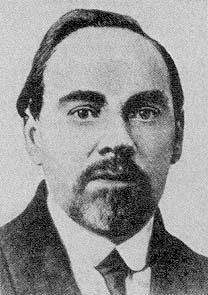
1.
Aleksandr Bogdanov, whose writings
on proletarian culture inspired the
Proletkult movement.
Source: Pod znamenem marksizma ,
no. 4 (1928).
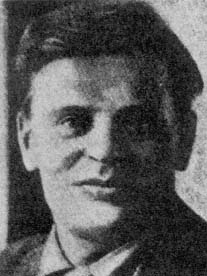
2.
Valerian Pletnev, playwright and
Proletkult president from December
1920 until August 1932.
Source: Pechat' i revoliutsiia ,
no. 7 (1927).
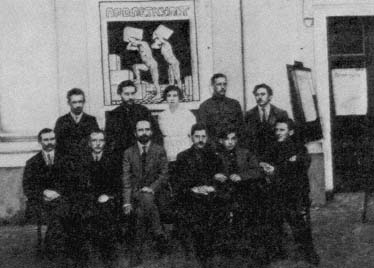
3.
The presidium of the national Proletkult organization elected at the
first national conference, September 1918. Sitting from left to right:
Fedor Kalinin, Vladimir Faidysh, Pavel Lebedev-Polianskii, Aleksei
Samobytnik-Mashirov, I. I. Nikitin, Vasilii Ignatov. Standing from
left to right: Stefan Krivtsov, Karl Ozol-Prednek, Anna Dodonova,
N. M. Vasilevskii, Vladimir Kirillov.
Source: Protokoly pervoi Vserossiiskoi konferentsii proletarskikh
kul'turno-prosvetitel'nykh organizatsii, 15–20 sentiabria, 1918 g .,
ed. P. I. Lebedev-Polianskii (Moscow, 1918).
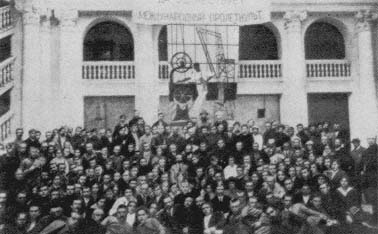
4.
Delegates to the first national Proletkult conference sitting under a
banner that reads "Long Live the International Proletkult."
Source: Protokoly pervoi Vserossiiskoi konferentsii proletarskikh
kul'turno-prosvetitel'nykh organizatsii, 15–20 sentiabria, 1918 g .,
ed. P. I. Lebedev-Polianskii (Moscow, 1918).
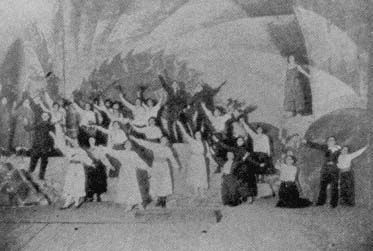
5.
Members of the Petrograd Proletkult drama studio performing a
collective reading of Walt Whitman's poem "Europe."
Source: Plamia , no. 21 (1918).
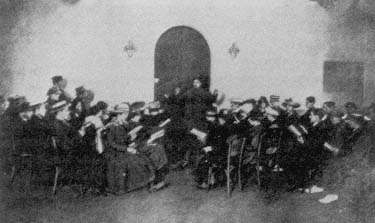
6.
A choral class in the Petrograd Proletkult.
Source: Plamia , no. 9 (1918).
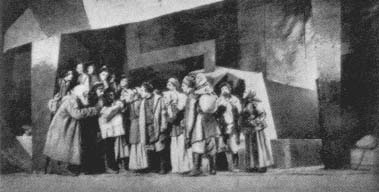
7.
A scene from Valerian Pletnev's play Lena, which is about the strike
that led to the Lena Massacre. The play is being staged by the First
Workers' Theater in Moscow.
Source: Huntly Carter, The New Theatre and Cinema of Soviet
Russia (London, 1924).
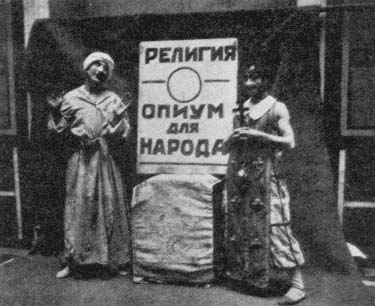
8.
A scene from Ostrovsky's play Enough Simplicity for Every Wise Man .
The play was radically revised by Sergei Eisenstein and Sergei Tretiakov
for the First Workers' Theater. The poster reads: "Religion is the
Opiate of the People."
Source: Huntly Carter, The New Theatre and Cinema of Soviet
Russia (London, 1924).

9.
A draft of a panel by the artist Ia. M. Guminer to decorate the Smolnyi
Institute in Petrograd for the first anniversary of the revolution.
The caption reads: "Proletkult—Proletarian Creation Guarantees
the World Commune."
Source: I. M. Bibikova and N. I. Levchenko, Agitatsionnomassovoe
iskusstvo: Oformlenie prazdnestv (Moscow, 1984), vol. 2.
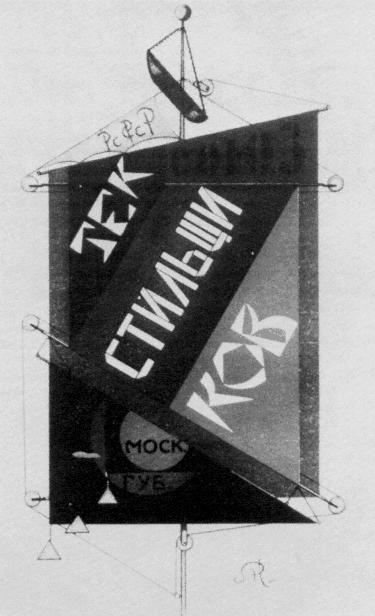
10.
A sketch of a banner for the Moscow Province Textile Workers'
Union designed by members of the Moscow Proletkult art studios.
An example of production art, the banner was to be made from
materials characteristic of the textile trade and to have moving parts
that evoked the workings of spinning machines.
Source: Gorn , no. 7 (1922).
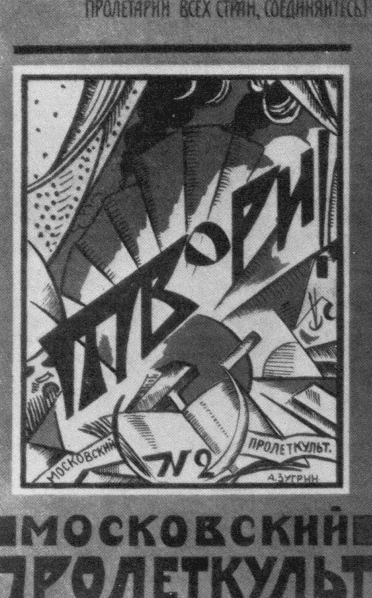
11.
A cover for the Moscow Proletkult journal Create! (Tvori! ) by the
proletarian artist Aleksandr Zugrin. The top caption reads "Proletarians
of all lands, unite!"
Source: Tvori! , no. 2 (1921).
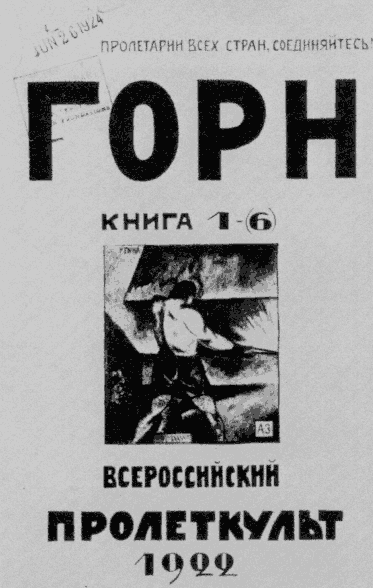
12.
A cover for the Moscow Proletkult journal Furnace (Gorn ) by the
proletarian artist Aleksandr Zugrin. The drawing, "At the Furnace,"
shows a blacksmith at his anvil, a very common image in Proletkult art.
Source: Gorn , no. 6 (1922).
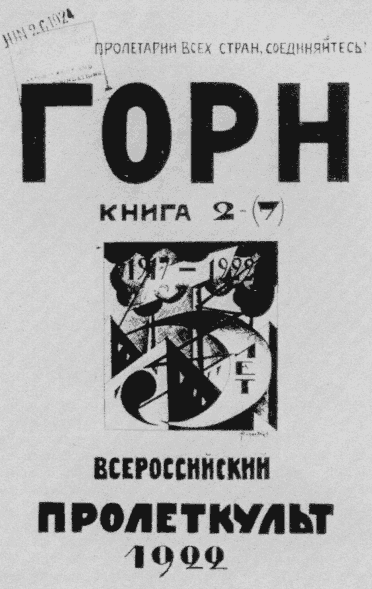
13.
An illustration from the cover of the Moscow Proletkult journal
Furnace (Gorn ) commemorating the fifth anniversary of the Proletkult.
Source: Gorn , no. 7 (1922).